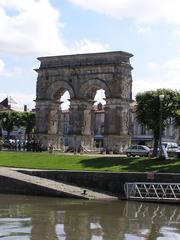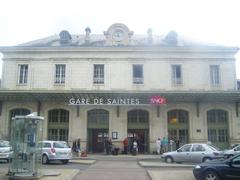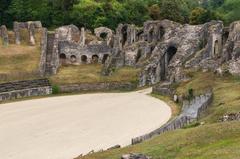
Sainte-Marie-Des-Dames Abbey: Visiting Hours, Tickets, and Guide to Saintes Historical Sites
Date: 04/07/2025
Introduction to Sainte-Marie-Des-Dames Abbey
Located in the heart of Saintes, France, the Abbaye aux Dames—also known as Sainte-Marie-des-Dames—is a landmark of Romanesque architecture and a vibrant center of musical and cultural life. Founded in 1047 by Geoffrey II, Count of Anjou, and Agnes of Burgundy, this Benedictine nunnery was the region’s first and played a pivotal role in both spiritual and civic life. Over nearly a millennium, the abbey has witnessed periods of prosperity, turmoil, destruction, and revival, evolving from a medieval monastic powerhouse to a celebrated “cité musicale” hosting the internationally renowned Festival de Saintes each July. Today, it stands as an essential destination for history enthusiasts, architecture lovers, and cultural travelers alike (Abbaye aux Dames; Wikipedia; France Voyage).
Table of Contents
- Introduction
- Historical Overview: Foundation to Modern Day
- Architectural and Artistic Highlights
- Visitor Information: Hours, Tickets, and Accessibility
- Exploring Saintes: Key Attractions and Travel Tips
- Frequently Asked Questions (FAQ)
- Conclusion
- References
Historical Overview: Foundation to Modern Day
Foundation and Early Growth (11th–12th Centuries)
The abbey was established in 1047 on the right bank of the Charente River, near the ancient basilica of Bishop Pallais. Its foundation marked the first Benedictine nunnery in the Saintonge region, with an abbess always chosen from the local nobility. Directly attached to the papacy, the abbey enjoyed rare privileges and autonomy for a female religious institution. By the mid-12th century, the original structures had been replaced with the current Romanesque church, renowned for its white stone façade and “pine cone” bell tower—a signature of Saintonge Romanesque style (Religiana; Saintes Tourisme).
Medieval Prosperity and Influence
During the Middle Ages, the abbey flourished, growing wealthy and influential. It minted currency and became a center for the education of noble girls, with up to 100 nuns from leading families. The abbey’s alumnae include figures like Madame de Montespan, a future favorite at the court of Louis XIV. Royal protection, especially from 1378 onward, and donations from notables such as Eleanor of Aquitaine, further enhanced its prestige (Wikipedia).
Turmoil, Destruction, and Reconstruction (14th–17th Centuries)
The abbey endured significant adversity during the Hundred Years’ War and the French Wars of Religion, suffering destruction and near-total ruin. A catastrophic fire in 1648 prompted extensive rebuilding under Abbess Françoise de Foix. The resulting architectural ensemble combines the 12th-century Romanesque church with 17th-century classical conventual buildings (Saintes Tourisme).
Revolution, Decline, and Secularization (18th–19th Centuries)
By the 18th century, monastic life was in decline. The French Revolution led to the nuns’ expulsion and the abbey’s conversion into a prison and then military barracks. Restoration attempts in the 19th century failed, and the site was largely abandoned following World War II (Religiana).
Modern Revival (20th–21st Centuries)
A turning point came in 1924 when the city of Saintes purchased the church, leading to restoration and its return to Catholic worship in 1939. The entire complex was classified as a Monument Historique in 1948, preserving it for future generations (Monumentum). Since the 1970s, the conventual buildings have been restored and repurposed as a vibrant music and cultural center, hosting the Festival de Saintes and the Jeune Orchestre de l’Abbaye (Musique Abbaye aux Dames).
Architectural and Artistic Highlights
Romanesque Masterpiece
The abbey church, Sainte-Marie-des-Dames, is a highlight of Romanesque architecture, featuring robust forms, harmonious proportions, and intricate sculptural details on its western façade and portal. The distinctive “pine cone” bell tower (en pomme de pin) is an engineering marvel and a symbol of the city (cparici.com).
Interior and Artistic Elements
Inside, a series of domed bays, supported by massive piers and pointed arches, guide visitors toward the altar. Light filters through the clerestory and modern stained glass, creating a tranquil atmosphere. Notably, the church also displays tapestries depicting the Book of Genesis by Jean-François Favre during certain seasons (catholiques17.fr).
Conventual Buildings and Cloister
Although the medieval cloister was destroyed, the 17th-century conventual buildings showcase classical design and include the accessible Marguerite Room and a medicinal garden. These spaces reflect both the Benedictine monastic tradition and the abbey’s ongoing cultural mission.
Adaptive Reuse
Today’s abbey masterfully blends its historic fabric with modern amenities. Restoration efforts have preserved its unique features, while new uses—concerts, exhibitions, and educational workshops—make it a living monument (Abbaye aux Dames).
Visitor Information: Hours, Tickets, and Accessibility
Opening Hours
- Church and Conventual Buildings: Open Tuesday to Sunday, 10:00 AM–6:00 PM (last admission 5:30 PM). Closed Mondays and major holidays.
- Festival de Saintes (July): Extended hours and special event access.
Tickets and Pricing
- General Admission: €8–€9 for adults (varies by exhibition or tour)
- Reduced Rate: €5 for students and seniors
- Children under 12: Free
- Special Events/Guided Tours: €5–€10; purchase online or at the entrance (Abbaye aux Dames – Visites)
Accessibility
- Wheelchair accessible, including the renovated Marguerite Room
- Adapted facilities and accessible pathways
- Free parking on-site
- Café and gift shop within the convent buildings
Guided Tours and Experiences
- Multilingual guided tours offered daily
- Audio guides and interactive sound journeys available
- Educational workshops for all ages
- Festival de Saintes and other cultural events throughout the year
Exploring Saintes: Key Attractions and Travel Tips
Major Historical Sites
- Gallo-Roman Amphitheatre: Open 9:00 AM–6:00 PM, €5 admission (France Voyage)
- Arch of Germanicus: Free access, riverside location
- Church of St. Eutropius: UNESCO World Heritage, daily 9:00 AM–6:00 PM, free
- Cathedral of St. Peter: Daily 9:00 AM–7:00 PM, free
Museums and Exhibitions
- Échevinage Museum: €4, Tuesday–Sunday, 10:00 AM–6:00 PM
- Dupuy-Mestreau Museum: €5, Tuesday–Sunday, 10:00 AM–6:00 PM
- Archaeological Museum: €6, daily 9:00 AM–6:00 PM
Combined and family tickets are available for savings across multiple sites.
Travel and Accessibility
- Saintes is compact and walkable; most attractions are within easy reach of each other.
- Detailed accessibility information and maps are available at the Office de Tourisme des Saintes.
- Public transport, parking, and local dining options are plentiful.
Events and Festivals
- Festival de Saintes: Major classical music festival each July
- Heritage Days (September): Special access and events at historic sites
- Local Markets: Weekly produce and craft markets showcase regional flavors
Frequently Asked Questions (FAQ)
Q: What are the visiting hours for the Abbaye aux Dames?
A: Tuesday to Sunday, 10:00 AM–6:00 PM; extended during the Festival de Saintes.
Q: How do I buy tickets?
A: Tickets are available online (official site) or at the entrance.
Q: Is the abbey accessible for visitors with disabilities?
A: Yes, the site provides wheelchair access, adapted facilities, and accessible tours.
Q: Can I attend concerts or other events?
A: Yes, the abbey hosts concerts year-round, especially during the Festival de Saintes. Check the events calendar.
Q: Are guided tours available?
A: Yes, guided tours are offered daily in multiple languages.
Q: Are pets allowed?
A: Only service animals are permitted inside the abbey.
Q: Can I take photographs?
A: Photography is allowed without flash; tripods are not permitted.
Q: Is there a café on site?
A: Yes, a café within the convent buildings offers refreshments.
Conclusion
The Abbaye aux Dames is a living testament to Saintes’ rich spiritual, artistic, and communal heritage. Its storied past, architectural splendor, and ongoing cultural programming make it an essential stop for any visitor. Whether you are drawn by Romanesque art, medieval history, or world-class music festivals, the abbey offers a memorable and meaningful experience. Plan your visit today and immerse yourself in the enduring legacy of Sainte-Marie-des-Dames.
For updated information on hours, ticketing, and events, consult the official Abbaye aux Dames website. Enhance your visit with the Audiala app for audio guides and interactive experiences, and follow us on social media for insights and travel inspiration.
Images
References
- Abbaye aux Dames
- France Voyage: Abbaye aux Dames
- Wikipedia: Abbaye aux Dames, Saintes
- Wikipedia (French): Abbaye aux Dames de Saintes
- Religiana: Abbaye aux Dames, Saintes
- Saintes Tourisme: Abbaye aux Dames
- Musique Abbaye aux Dames: Festival de Saintes 2025
- Spotting History: Abbaye aux Dames
- France Voyage: Tourism in Saintes
Internal Links:
- Explore more about Saintes Historical Sites
- Discover the Festival de Saintes
External Links:
- Official Abbaye aux Dames website: https://abbayeauxdames.org/
- Festival de Saintes details: https://musique.abbayeauxdames.org/agenda/festival-de-saintes-2025/
- Monument Historique listing: https://monumentum.fr/monument-historique/pa00105245/saintes-ancienne-abbaye-des-dames



